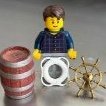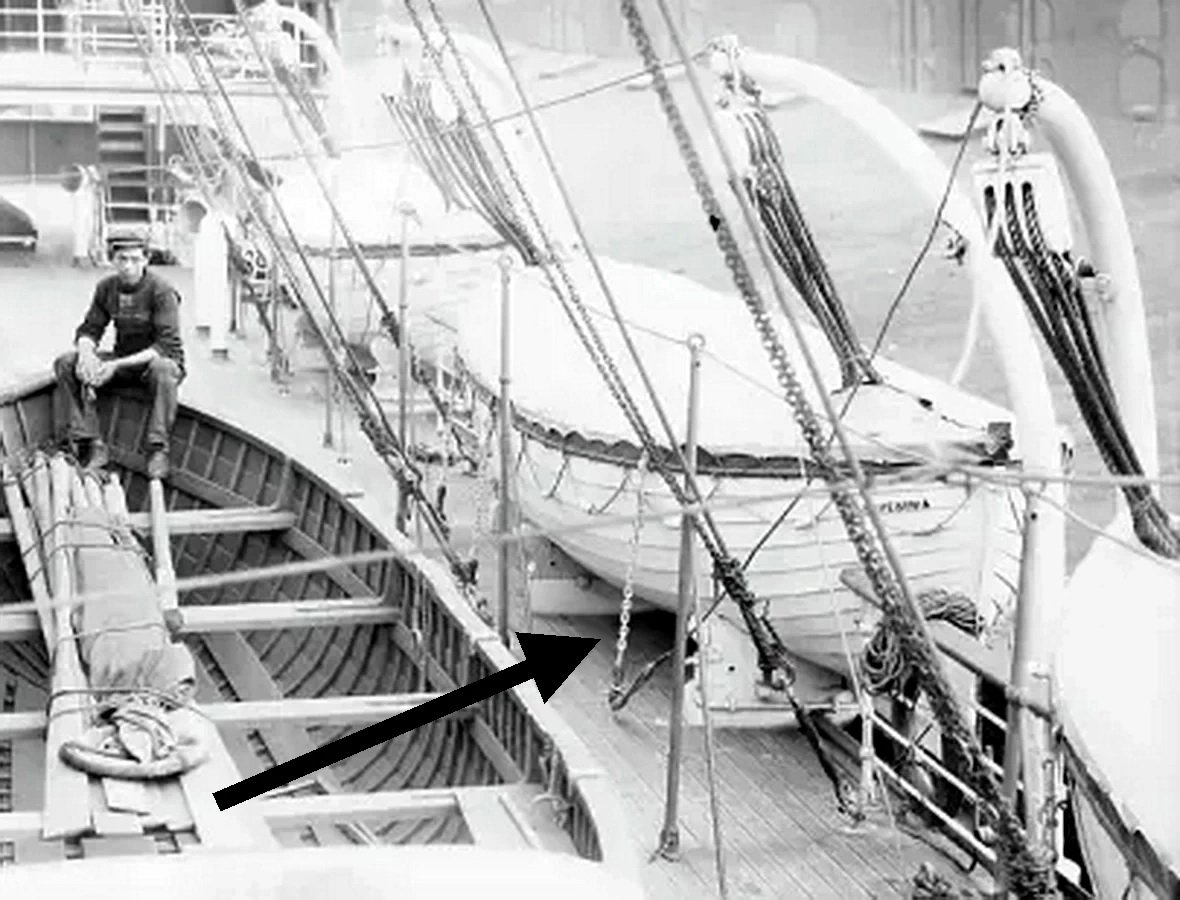-
Posts
271 -
Joined
-
Last visited
About madtatt

- Birthday 03/15/1968
Contact Methods
-
Website URL
https://www.instagram.com/shepherd_shipyard/
Profile Information
-
Gender
Male
-
Location
Germany, Herdecke
-
Interests
Warships 1:200
Recent Profile Visitors
-
I've finished the bridge and its girder and am now starting to add more details. First, I'll take care of the signal flags. So I created this prototype. For this, I've built a small wooden cabinet out of styrene to store the flags, which I'll probably make from tissue paper. I'm toying with the idea of having a figure here later, holding one of the signal lines to raise a flag, something like this... Now I have to build four of these little cabinets first, I'll keep you posted.
- 207 replies
-
- Russo-Japanese War
- Mikasa
-
(and 2 more)
Tagged with:
-
 madtatt reacted to a post in a topic:
IJN Mikasa by Herby63 - Merit International with Pontos set - 1/200 - PLASTIC
madtatt reacted to a post in a topic:
IJN Mikasa by Herby63 - Merit International with Pontos set - 1/200 - PLASTIC
-
 Canute reacted to a post in a topic:
U-47 by RVB (Rick) - Amati - Scale 1/72 - Length 92.4cm or 36.38 inches - marketed by Model Shipways c. 2013
Canute reacted to a post in a topic:
U-47 by RVB (Rick) - Amati - Scale 1/72 - Length 92.4cm or 36.38 inches - marketed by Model Shipways c. 2013
-
 robert952 reacted to a post in a topic:
U-47 by RVB (Rick) - Amati - Scale 1/72 - Length 92.4cm or 36.38 inches - marketed by Model Shipways c. 2013
robert952 reacted to a post in a topic:
U-47 by RVB (Rick) - Amati - Scale 1/72 - Length 92.4cm or 36.38 inches - marketed by Model Shipways c. 2013
-
 madtatt reacted to a post in a topic:
RMS Titanic by Massimodels – Minicraft – 1:350 – PLASTIC – Tom's Modelworks
madtatt reacted to a post in a topic:
RMS Titanic by Massimodels – Minicraft – 1:350 – PLASTIC – Tom's Modelworks
-
 madtatt reacted to a post in a topic:
RMS Titanic by Massimodels – Minicraft – 1:350 – PLASTIC – Tom's Modelworks
madtatt reacted to a post in a topic:
RMS Titanic by Massimodels – Minicraft – 1:350 – PLASTIC – Tom's Modelworks
-
@Jeff59 Thank you. And once again, thank you for this valuable information, Jeff. You are a wellspring of knowledge. 👏
- 207 replies
-
- Russo-Japanese War
- Mikasa
-
(and 2 more)
Tagged with:
-
Hi Terry. It's very unfortunate that Amati is letting its customers down with such errors. It just goes to show that companies don't think it's necessary to do a little research before launching a product. Especially since the effort required to gather this information is extremely small. Despite everything, you're making a great model out of it. 👍
-
 madtatt reacted to a post in a topic:
U-47 by RVB (Rick) - Amati - Scale 1/72 - Length 92.4cm or 36.38 inches - marketed by Model Shipways c. 2013
madtatt reacted to a post in a topic:
U-47 by RVB (Rick) - Amati - Scale 1/72 - Length 92.4cm or 36.38 inches - marketed by Model Shipways c. 2013
-
 Canute reacted to a post in a topic:
U-47 by RVB (Rick) - Amati - Scale 1/72 - Length 92.4cm or 36.38 inches - marketed by Model Shipways c. 2013
Canute reacted to a post in a topic:
U-47 by RVB (Rick) - Amati - Scale 1/72 - Length 92.4cm or 36.38 inches - marketed by Model Shipways c. 2013
-
 madtatt reacted to a post in a topic:
IJN Mikasa by Herby63 - Merit International with Pontos set - 1/200 - PLASTIC
madtatt reacted to a post in a topic:
IJN Mikasa by Herby63 - Merit International with Pontos set - 1/200 - PLASTIC
-
 madtatt reacted to a post in a topic:
IJN Mikasa by Herby63 - Merit International with Pontos set - 1/200 - PLASTIC
madtatt reacted to a post in a topic:
IJN Mikasa by Herby63 - Merit International with Pontos set - 1/200 - PLASTIC
-
Hi Terry, a beautiful and interesting build.👍 However, there's one thing that's not quite right. DKM submarines don't have a red underwater hull. The hull color corresponds to today's RAL 7016, or anthracite gray. I don't know how historically accurate you want your model to be, but I thought I'd point it out. 😉
-
Happy New Year, everyone! Let’s get our glue out again in 2026 and, above all, stay healthy so we can continue our wonderful hobby. I used my day off to tackle another tricky task.You might remember that I wanted to do things differently than planned when mounting the posts that support the bridge on the bridge deck. First, I glued the bridge securely in place yesterday and let it dry thoroughly until this morning.Then I pushed the posts through the holes I had already prepared. The profiles at the top were cut to size, and that was it. A little brown paint, and you can’t see them anymore. Then I attached the support pillars at the front. That was a bit tricky, to be honest, but it worked. Thanks in part to my assembly stand, which allowed me to lay the model on its side again and made the job much easier. And so the bridge and its supports are now in place. It wasn’t easy to align all the support pillars perfectly straight and parallel to each other. I really like working with the team below me. The posts still need to be aged, but I'll do that this weekend.
- 207 replies
-
- Russo-Japanese War
- Mikasa
-
(and 2 more)
Tagged with:
-
 madtatt reacted to a post in a topic:
IJN Mikasa by Herby63 - Merit International with Pontos set - 1/200 - PLASTIC
madtatt reacted to a post in a topic:
IJN Mikasa by Herby63 - Merit International with Pontos set - 1/200 - PLASTIC
-
Thank you so much for the lovely compliment, Chris. Yes, I plan to take the model to one or two trade fairs. First, the largest plastic model building fair here in Germany, the Euro Model Expo. And then there's one in the Netherlands, the Scale Model Challenge. And every now and then, friends of mine put on a temporary exhibition at the Maritime Museum in Hamburg. I'm also considering taking the Mikasa there. I'm already working on a transport box so it survives the journey undamaged.
- 207 replies
-
- Russo-Japanese War
- Mikasa
-
(and 2 more)
Tagged with:
-
Hello everyone. I used my time off to recruit even more crew. They’re actually members of the German Navy. But as soon as they received a nice new styrene flat cap, they started speaking Japanese. 😁 So I’m further increasing the number of available figures. Everyone dressed up and ready to board the ship. I remembered the words of user dafi from a German forum, who spoke of group formation, and I hope I’ve implemented it adequately. With a group of sailors talking amongst themselves. What could the boys possibly be chatting about as soon as the officer turned his back on them?! Something needs to be repaired on the fan cover, and a sailor is bringing more equipment to the storage lockers. An officer steps out of the armored command post and the sailor gives a brisk salute. At the stern, a sailor goes into the control station, and an officer keeps an eye on the boys working in the pinnace. I’ve already distributed the figures on the lower deckhouse, so now the upper bridge with the cams can finally be installed. I would have difficulty reaching those spots afterwards, so that’s how I did it before. Even these figures are barely visible afterwards, but again they give the model depth and a touch of life. The good thing is that I could easily use the DKM sailors with their incorrect clothing.
- 207 replies
-
- Russo-Japanese War
- Mikasa
-
(and 2 more)
Tagged with:
-
You're very welcome, Ferrus. And it seems you've hit the mark. Your tarp turned out great. And on your first try, impressive! 👍
- 17 replies
-
- barco rabelo
- 1/75
-
(and 2 more)
Tagged with:
-
@Ferrus Manus Thank you so much. I use tissue paper that I dye brown. Then I soak it in diluted wood glue and shape it. For example, I lay it over a boat and lift the paper with tweezers, folding it over itself to create an arrangement of folds. Then I let it dry thoroughly. After that, I apply a wash with very diluted dark brown paint. I let it dry again and then drybrush it with a light brown or light gray. I hope you find this helpful.
- 207 replies
-
- Russo-Japanese War
- Mikasa
-
(and 2 more)
Tagged with:
-
I’ve slightly opened up my assembly jig again to determine the positions of the launch and cutter. To do this, I removed the davits from their injection-molded frames and inserted them into the designated holes. Then, using a small strip of styrene profile, I positioned the boats at the same distance from the outer edge of the hull. So far, it’s looking pretty good. It’s definitely a tight fit, but I can get all the little boats in place. Before I secure them, though, I’ll make sure everything is perfectly aligned. I simulated the rope of the pulley system with a wire, and it fit quite well on the cutters. However, this doesn’t work with the barge. The arrow shows where the rope hits the stop and the barge has shifted backward. Here I need to raise the davits or modify the pulley system. And so the ship continues to take shape.
- 207 replies
-
- Russo-Japanese War
- Mikasa
-
(and 2 more)
Tagged with:
-
I have a small addendum regarding the cutters. It didn't seem right to me to leave the oars unsecured in the boat. So I secured them with a rope to prevent them from slipping. And this is what it looks like now on the Mikasa. And with that, I wish you all a wonderful and peaceful Christmas. 🎅
- 207 replies
-
- Russo-Japanese War
- Mikasa
-
(and 2 more)
Tagged with:
-
Oh man, how true. 😅 Not much has happened since the last post. But I finally managed to finish the top row of cutters and the steam launch. The oars have been distributed among the cutters. Here are the details again. I’ve distributed some more ropes. And I packed a little bit of tarpaulin into the boats. That’s how I tried to make them a little more varied. The barge has also been given a small anchor. At first, I wasn’t quite sure how to secure the cutters. But then I found a picture showing that even the small boats were secured with a chain hoist. And that’s how I implemented it. And I wish everyone here a Merry Christmas. 🎅
- 207 replies
-
- Russo-Japanese War
- Mikasa
-
(and 2 more)
Tagged with:
-
Thank you so much, Jeff, and Merry Christmas to you too! That's right, I've finally finished the little cutters and I'll show them to you in a moment. I'm really looking forward to seeing your display case when you present it here. And I can only return the thanks for the tips and support, Jeff. Here's to a happy new year with lots of glue! And now to the boats. Aged… …and positioned for testing. I definitely like it better than with the white floorboards.
- 207 replies
-
- Russo-Japanese War
- Mikasa
-
(and 2 more)
Tagged with:
-
The little mast is absolutely fantastic. What a tiny gem! 🫠 I also have that small vise, by the way, and I think it's great too.
- 39 replies
-
- Five Star
- Akitsu Maru
-
(and 1 more)
Tagged with:
About us
Modelshipworld - Advancing Ship Modeling through Research
SSL Secured
Your security is important for us so this Website is SSL-Secured
NRG Mailing Address
Nautical Research Guild
237 South Lincoln Street
Westmont IL, 60559-1917
Model Ship World ® and the MSW logo are Registered Trademarks, and belong to the Nautical Research Guild (United States Patent and Trademark Office: No. 6,929,264 & No. 6,929,274, registered Dec. 20, 2022)
Helpful Links
About the NRG
If you enjoy building ship models that are historically accurate as well as beautiful, then The Nautical Research Guild (NRG) is just right for you.
The Guild is a non-profit educational organization whose mission is to “Advance Ship Modeling Through Research”. We provide support to our members in their efforts to raise the quality of their model ships.
The Nautical Research Guild has published our world-renowned quarterly magazine, The Nautical Research Journal, since 1955. The pages of the Journal are full of articles by accomplished ship modelers who show you how they create those exquisite details on their models, and by maritime historians who show you the correct details to build. The Journal is available in both print and digital editions. Go to the NRG web site (www.thenrg.org) to download a complimentary digital copy of the Journal. The NRG also publishes plan sets, books and compilations of back issues of the Journal and the former Ships in Scale and Model Ship Builder magazines.





